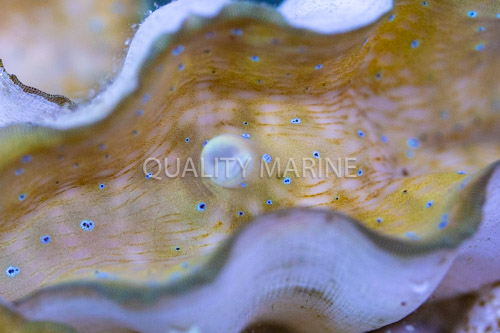The Gentle Giant: Tridacnid Gigas Clam

Many reef aquarium hobbyists are well familiar with the Tridacnid family of giant clams, but for most of them, the giant moniker is relative. Theres genuinely only one Tridacnid that embodies this name, and its THE giant clam; Tridacnid gigas. Allowed to mature, these clams can easily surpass lengths of 2 feet, with the world record holder being generously over 4 feet and weighing over a quarter of a ton, holding the record for length only as another shorter specimen was found to weigh over 700 pounds. These are the clams of some mythical lore that give way to the man-eater stories. These animals, however, are gentle giants deriving their nutrition not from predatory traits but mostly from microscopic algae that live within its mantle called zooxanthellae. Indeed a quick closing reaction from the gigas clam is a defensive mechanism and not one of aggression. Zooxanthellae algae is photosynthetic providing the clam with its main food source as adults, as smaller juveniles rely mostly on filter-feeding, ingesting plankton and other forms of organic detritus. Photosynthesis is what allows these bivalves to grow to such impressive lengths, even in nutrient poor tropical waters (much like many of the corals available in the hobby). Gigas are found throughout the Eastern Indian Ocean and West Pacific Ocean.

Large specimens are continually found less frequently, not because of the ornamental aquarium trade but due to consumption for food by humans. Its a delicacy enjoyed not only throughout its natural range but also in many other parts of the world, many know it as himejako, its Japanese name that it is sold under at many restaurants internationally. Gigas clams take many years to reach their full potential and can reproduce through sexual means only once they have reached a length near a foot, with juvenile cams initially being planktonic. Most specimens are found in high light intertidal zones, sometimes even being exposed to air at low tide so it is easy to see why they are easy to pick off. The silver lining to this is that gigas are now cultured in mass for both food and for keeping in captivity along with other members of the Tridacnidae family. You can distinguish adult gigas with relative ease, they possess a more muted color palette than most of the families smaller members, ranging from different shades of green, yellow and brown with dotted patterns. Their mantles are noticeably more bumpy than other Tridacnids as well. The family member that they are most similar in appearance to is T. deresa, but you can differentiate them due to the gigas being the only Tridacnid that can conceal its mantle in its entirety.
In the home aquarium youll want to create a high light environment that mimics a shallow turbid reef environment, their zooxanthella is solely relying on an intense light source and you will not be able to sustain these creatures through supplemental feeding alone.. While these clams can bore into rock in the wild, your best bet is to put them in the substrate with unobstructed access to the light source. The dosing of phytoplankton and other nutritional organic compounds such as amino-acids is recommended. Clams are surprisingly resistant to higher levels of dissolved nutrients, some even thriving in said conditions. In general, youll want to mimic the same conditions you would ask for hermatypic corals, like SPS, in your husbandry regimen. Like many other sessile invertebrates, modular and turbulent flow is welcome while directed linear flow may cause them to retreat into their mantles, missing out on nutrition. Also like hard corals, gigas clams produce their shell (the hard part) not through nutrition alone but with dissolved calcium carbonate so youll want to make sure your calcium and alkalinity levels mimic that of a reef environment. It cant be overstated that these grow large and live for quite a long time under ideal conditions, while juveniles may find adequate housing in even small aquaria, youll eventually want to give them a minimum surface area of 24x12 inches should you plan to keep them long term.
These clams of legend provided with proper husbandry techniques and an appropriate system can become the centerpiece not only of your aquarium but have a commanding presence that is sure to become a conversation starter.